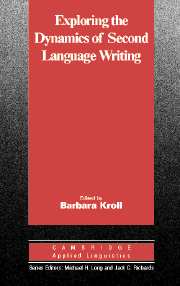Book contents
- Frontmatter
- Contents
- List of contributors
- Acknowledgments
- List of abbreviations used
- Series editors' preface
- Introduction: Teaching the next generation of second language writers
- I EXPLORING THE FIELD OF SECOND LANGUAGE WRITING
- Chapter 1 Second language writing in the twentieth century: A situated historical perspective
- Chapter 2 Research on second language writing: An overview of what we investigate and how
- II EXPLORING THE VOICES OF KEY STAKEHOLDERS:TEACHERS AND STUDENTS
- III EXPLORING WRITERS' FINISHED TEXTS
- IV EXPLORING CONTEXTUALITIES OF TEXTS
- V EXPLORING TECHNOLOGY
- EPILOGUE: EXPLORING OURSELVES
- Index
Chapter 1 - Second language writing in the twentieth century: A situated historical perspective
Published online by Cambridge University Press: 05 October 2012
- Frontmatter
- Contents
- List of contributors
- Acknowledgments
- List of abbreviations used
- Series editors' preface
- Introduction: Teaching the next generation of second language writers
- I EXPLORING THE FIELD OF SECOND LANGUAGE WRITING
- Chapter 1 Second language writing in the twentieth century: A situated historical perspective
- Chapter 2 Research on second language writing: An overview of what we investigate and how
- II EXPLORING THE VOICES OF KEY STAKEHOLDERS:TEACHERS AND STUDENTS
- III EXPLORING WRITERS' FINISHED TEXTS
- IV EXPLORING CONTEXTUALITIES OF TEXTS
- V EXPLORING TECHNOLOGY
- EPILOGUE: EXPLORING OURSELVES
- Index
Summary
Existing historical accounts of studies in second language (L2) writing, which began to appear in the 1990s, usually begin with the 1960s and catalogue pedagogical approaches or emphases (e.g., Leki, 1992; Raimes, 1991; Silva, 1990). It is not historically insignificant that many researchers see the 1960s as the beginning of the discipline, that they focus on pedagogical approaches or emphases, and that historical accounts began to appear in the 1990s because these accounts embody a set of assumptions about the disciplinary and epistemological status of second language writing. That is, these accounts tend to position second language writing as a subfield of second language studies and present the primary responsibility of second language writing researchers as the development of pedagogical knowledge in the service of advancing the field. Yet, a broader view of the history seems to suggest the limitations of these assumptions. Although it is true that writing issues began to attract serious attention from L2 specialists only in the 1960s, historical evidence suggests that L2 writing instruction did not suddenly become an issue in the 1960s (Matsuda, 1999). Furthermore, the rise of historical consciousness in the early 1990s seems to indicate that the nature of second language writing studies began to change around that time.
My goal in this chapter is to provide an understanding of the dynamics of the field of second language writing by considering its development from a broader, interdisciplinary perspective.
- Type
- Chapter
- Information
- Exploring the Dynamics of Second Language Writing , pp. 15 - 34Publisher: Cambridge University PressPrint publication year: 2003
- 36
- Cited by



